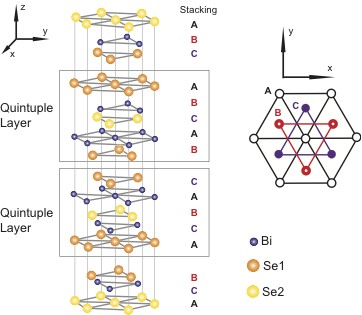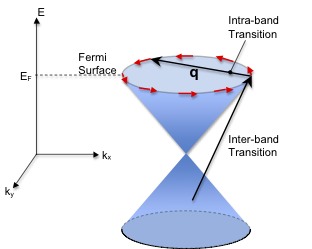- Connecting electron and phonon spectroscopy to determine quasiparticle-phonon coupling
Both electron and phonon spectrscopy can be used to yield estimates of the electron-phonon coupling parameter λ, which provides a dimensionless estimate of the strength of the interaction in a particular material. However, recently there has been discrepancy in reported values for the topological insulators Bi2Se3 / Bi2Te3 appearing in the literature. By employing a Matsubara-Green's function formalism, we have developed a technique for translating features in phonon spectra into electronic spectral functions (see an example below), which allows direct comparison with angle resolved photoemission spectroscopy.
- Graphene and the Kekule mode
Graphene, a single sheet of carbon atoms, is at the forefront of much modern condensed matter research. Its unique electronic dispersion and incredible structural properties make it a promising candidate for new, novel materials. However, one of its drawbacks is its semi-metal character, with Dirac points at the K and K' points in the Brilluoin zone, which limits its usefulness in electronics. If one could endow the charge carriers in graphene with a finite effective mass, and thereby induce an electronic gap, new pathways for graphene's role in modern electronics could be opened!
- Topological Insulators Bi2Se3 / Bi2Te3
These compounds, previously known for their favorable thermoelectric properties, have become the new star materials in the growing field of topological insulators. These materials exhibit conductive surface states despite being insulators throughout their bulk. In particular Bi2Se3 and Bi2Te3 exhibit surface electronic states with linear dispersion in the form of a single Dirac Cone at the center of their surface Brillouin zone. The relatively large bandgap (~0.3 eV) in Bi2Se3 makes it an ideal candidate for theoretical and experimental study, as well as potential applications in spintronics. Below you can see an image of the rhomohedral unit cell as well as the isotropic surface Dirac cone dispersion with arrows indicating the electronic transitions possible as the result of scattering from phonons.


- LiCu2O2
The corrugation of the Li-Cu-O (001) surface obtained from the diffraction spectra:
An interesting structural transition was found on this surface, as indicated in the animation below:

- NaxCoO2
A new material found with very high themo-electricity and superconductivity behavior.
- Sr2CuO2Cl2
Structure and lattice dynamics of Sr2CuO2Cl2(001) studied by helium-atom scattering
M. Farzaneh, X.-F. Liu, M. El-Batanouny, and F. C. Chou, Phys. Rev. B 72, 085409 (2005).
- CoO
Antiferromagnetic Ordering on CoO(001) Studied by Metastable Helium Beam Diffraction
P. Banerjee, X. Liu, M. Farzaneh, C.R. Willis, W. Franzen, and M. El-Batanouny, arXiv:cond-mat/0401130v1.
- NiO
M. Marynowski, W. Franzen, M. El-Batanouny, and V. Staemmler, Phys. Rev. B 60, 6053 (1999).
Frozen spin-wave structure on the NiO(100) surface observed by metastable He 23
S scattering:A. Swan, M. Marynowski, W. Franzen, M. El-Batanouny, and K. M. Martini, Phys. Rev. Lett.71, 1250 (1993).